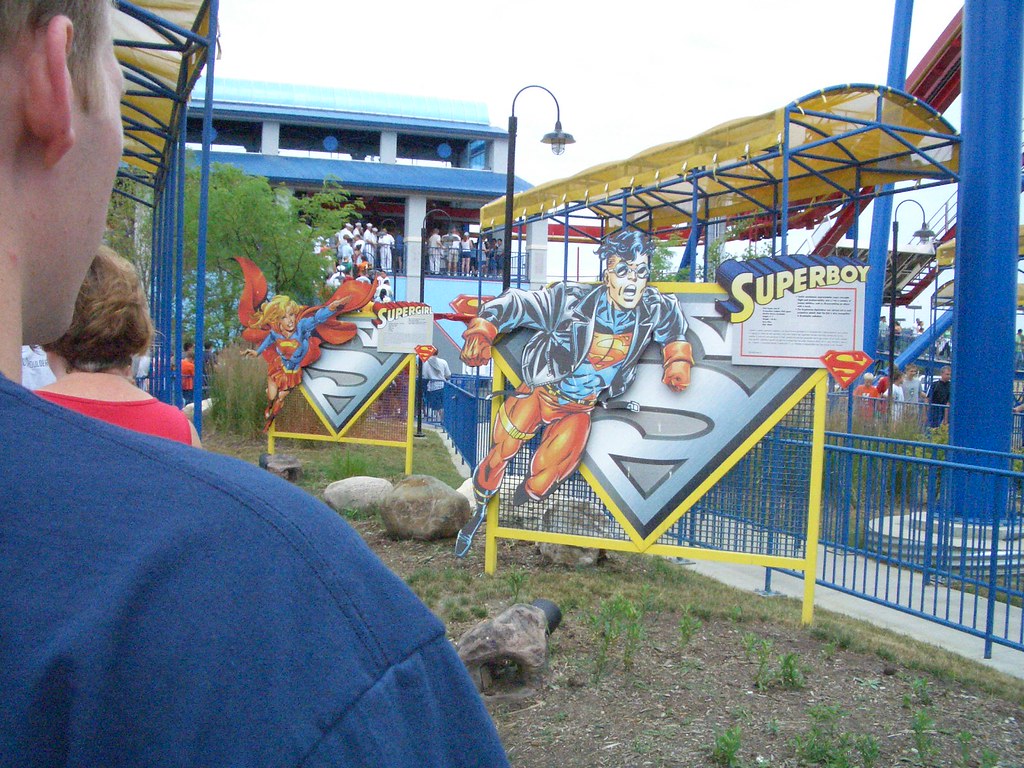 Six Flags Great America is your average crazy theme park. You wait in long lines (~45 min) for really fast rides (~60 mph) that are over before you know it (~45 sec). Each ride has a theme, and the theme is depicted with displays all along the waiting line.
Six Flags Great America is your average crazy theme park. You wait in long lines (~45 min) for really fast rides (~60 mph) that are over before you know it (~45 sec). Each ride has a theme, and the theme is depicted with displays all along the waiting line.For example, the Batman ride has a broken fire hydrant with water spraying out, a busted cop car spewing steam, an enormous black fan that blows chilling wind towards you, and dirty street signs from Gotham City. These few artifacts serve to create the general feeling that crime is running rampant and we need Batman's help. It's basically awesome.
But then you get to the Superman ride. And what you've got, both to put you in the mood and to occupy your attention, is a long series of character cut-outs, each with an explanation. The intention is great - "Here you can learn every single character that ever appeared on Superman." But the execution is really poor. Tiny text. So small, you have to lean over the railing and squint. Tons of data. The character's name, special powers, weaknesses, what they wear, how they know Superman, etc. etc. etc. It's tiresome and draining, and you quickly feel impatient with the slow-moving line.
The key difference here is showing us versus telling us. In Batman, you see a few tangible objects, and your mind fills in the rest. You imagine the accident with the cop car, you picture the criminals, you feel the sewers. This is showing us, and it's very effective. It creates an experience that we can take part in.
In Superman, you are told a million fantastic facts that don't give any sort of visceral reaction. You can barely read the words. The characters quickly feel irrelevant. This is telling us, and it's information overload.
For all consumer experiences, the rule is simple. Whenever possible, show me, don't tell me.

4 comments:
For all consumer experiences, the rule is simple. Whenever possible, show me, don't tell me.
Not only is that so true, but it's the most simple and effective rule for all writing and all political arguments -- essentially any kind of experience-oriented communication. It's just good storytelling.
things i thought when i read this post:
first, it's interesting that the superman ride is more recent (it is, right?)--that this is what they chose to design in recent years. the batman ride was there in the mid-90s when i went at age 14. is the superman thing supposed to be nostalgic? like, old skool? or is it just cheap or lazy?
also, i wonder if certain qualities are being ignored or exaggerated in your praise of the batman set-up. i love it. but, do i love it b/c it was really unique in the 90s when i was young? because i also love disaster transport, which is this horribly stupid what-we-thought-the-future-would-be-like-in-the-80s rollar coaster at cedar point.
obviously creating a mood works much better in cases such as these. i don't necessarily think it's just a case of showing vs. telling, so much as the quality of the execution.
"Show, don't Tell." D@#&-it. I just learned this last week and guarded it as if it was the biggest secret ever. !@#$%^&*!! Now I see its common knowledge. Thanks.
I only liked the Superman ride better than the Batman ride last time I was at Six Flags because it was the only place in the entirety of Six Flags that I could escape that damn Venga Boys song... da da da da da da da-da. Shoot me!
Post a Comment